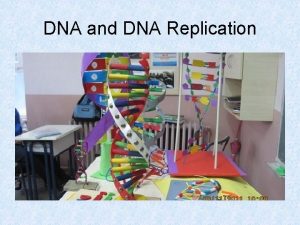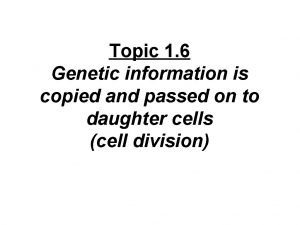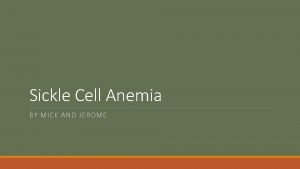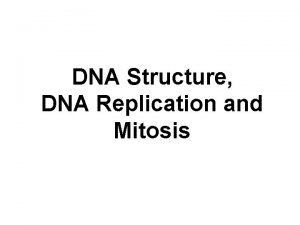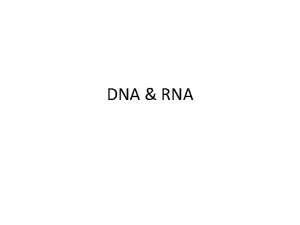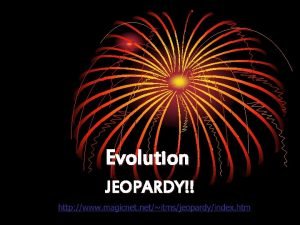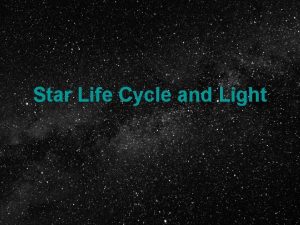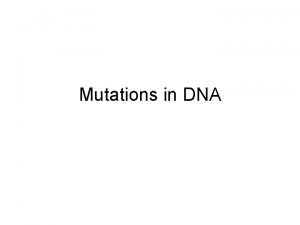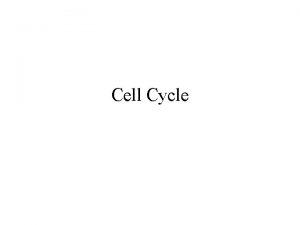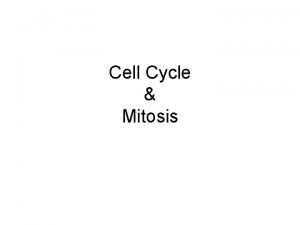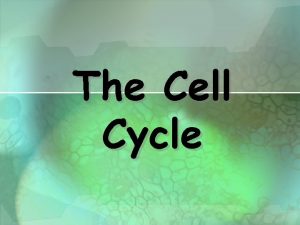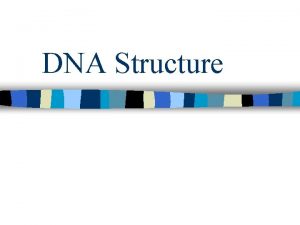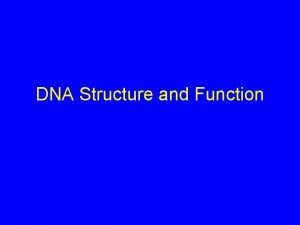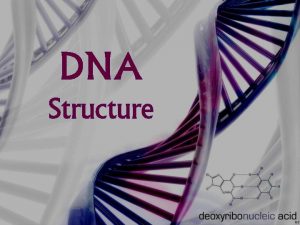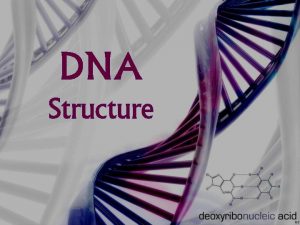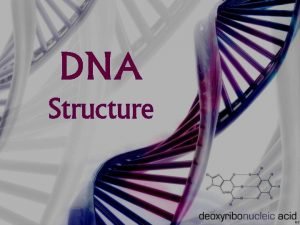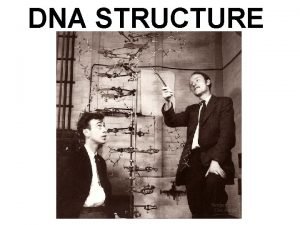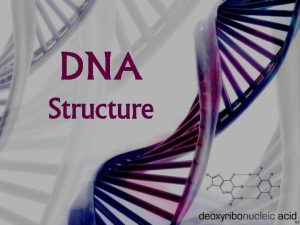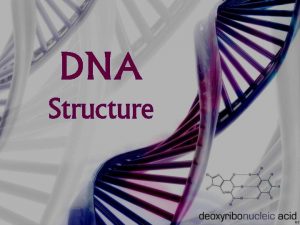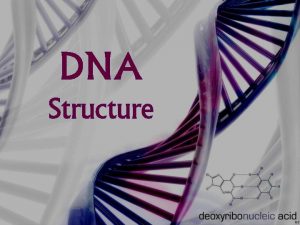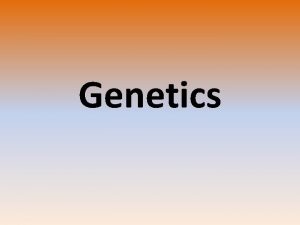DNA and cell cycle Video Cell Structure Genetics
























- Slides: 24

DNA and cell cycle Video – Cell Structure

Genetics: The study of how heredity information is passed from one generation to the next.

1) All living things are composed of one or more cells i. e. structural unit of life 2) Cells are the smallest functional units of living organisms 3) New cells come only from pre-existing cells by cell division

DNA is the genetic information that an individual inherits from his/her parents. DNA is double stranded and is called « Double helix » During cell division (mitosis), DNA is replicated so that each new cell receives an identical copy of the genetic information.

DNA is made up of many nucleotides joined together as a chain. This chain is known as a polynucleotide or nucleic acid

Phosphate group: -Binds to the deoxyribose to form the backbone of the DNA Nitrogenous base: A, T, C, G -bound to the sugar Pentose Sugar: -5 carbon ring -Deoxyribose

The Deoxyribose sugar on the DNA does not have an oxygen on the 2 nd carbon. RNA has a ribose sugar, which has an oxygen atom on the 2 nd carbon.

1) Pyrimidine: (single ring) - heterocyclic compound - Cytosine, Thymine and Uracil -Cytosine and thymine are found in DNA. 2) Purine: (double ring) -heterocyclic compound -2 ring structure - Adenine & Guanine Complementary base-pairing: Adenine – Thymine (one H bond) Guanine – Cytosine (two H

Genome: Complete DNA sequence of an organism.

What would the complementary strand be? A T T C G A A C T a) TA A G G T C A G b) TA A G C T T G A c) G C C A T G G T C

Chromatin: uncoiled DNA Chromosome: coiled DNA (many strands of chromatin)

Video http: //www. youtube. com/watch? v=gb. SIBh. Fw. Q 4 s

Process of growth and cell division One complete cycle produces two new identical ( but smaller)daughter cells One cycle takes approximately 12 -24 hours All somatic cells undergo the cycle 3 main phases: Interphase, Mitosis and Cytokinesis

5 -6 hours 10 – 12 hours 4 -6 hours Less than 1 hour

Stage where the cell grows and makes copies of genetic information and prepares the cell for division. Cell is carrying out life functions. G 1 (Growth 1) : synthesizes new molecules S (Synthesis): DNA is copied and is in the form of chromatin. G 2 (Growth 2): synthesizes more proteins that prepare for cell division.

The copied genetic material separates and prepares for the physical separation of two new daughter cells. The splitting of genetic information allows each new daughter cell to have identical genetic information. Subdivided into 4 main phases.


Chromatin condenses into chromosome Each chromosome exists as two copies of one chromosome The chromosome arms are « sister chromatids » and are joined at the center by the centromere. Nuclear membrane breaksdown and nucleolus disappears. The centrioles begin to release spindle fibers and migrate to opposite poles

Spindle fibers attach to the centromere of the sister chromatids The sister chromatids line up on the equator of the cell forming a metaphase plate.

Each centromere separates, causing the sister chromatids to separate. Spindle fibres contract. Each chromosome migrates to the opposite pole. One complete set of chromosomes is now at each pole of the cell.

Chromosomes unwind into chromatin Spindle fibers break down Nuclear membrane reforms around the new set of chromosomes Cleavage Furrow Nucleolus forms within each new nucleus.

Process of cytoplasmic division The cytoplasm physically divides and creates two new daughter cells The microfilaments on the cytoskeleton of the cell membrane pinch and separate the cytoplasm. The cytoplasm divides equally between the two cells.

Have a cell wall that is rigid A cell plate forms between the two nuclei and separates the two daughter cells. A new cell wall then forms around the cell plate.

p. 168 : 2, Video 3, 5, 8, 9, 10, 11
 Friedrich miescher discovery
Friedrich miescher discovery Pmat
Pmat Molecular genetics section 1 dna the genetic material
Molecular genetics section 1 dna the genetic material Coding dna and non coding dna
Coding dna and non coding dna Section 10-2 cell division
Section 10-2 cell division Cell cycle and cell division
Cell cycle and cell division Cell cycle mitosis
Cell cycle mitosis Replication fork
Replication fork Bioflix activity dna replication nucleotide pairing
Bioflix activity dna replication nucleotide pairing The principal enzyme involved in dna replication is
The principal enzyme involved in dna replication is Dna and genes chapter 11
Dna and genes chapter 11 Biology.arizona.edu/cell bio/activities/cell cycle/01.html
Biology.arizona.edu/cell bio/activities/cell cycle/01.html Is sickle cell anemia genetic
Is sickle cell anemia genetic Video b**** yandex
Video b**** yandex Gravity yahoo
Gravity yahoo Searchyahoo
Searchyahoo Digital media primer
Digital media primer Dna structure and replication pogil
Dna structure and replication pogil Multiple choice questions on dna structure and replication
Multiple choice questions on dna structure and replication What is the purpose of dna replication
What is the purpose of dna replication Rna
Rna Evolution jeopardy
Evolution jeopardy Brain pop water cycle
Brain pop water cycle Step by step life cycle of a star
Step by step life cycle of a star Sickle cell anemia dna sequence
Sickle cell anemia dna sequence
